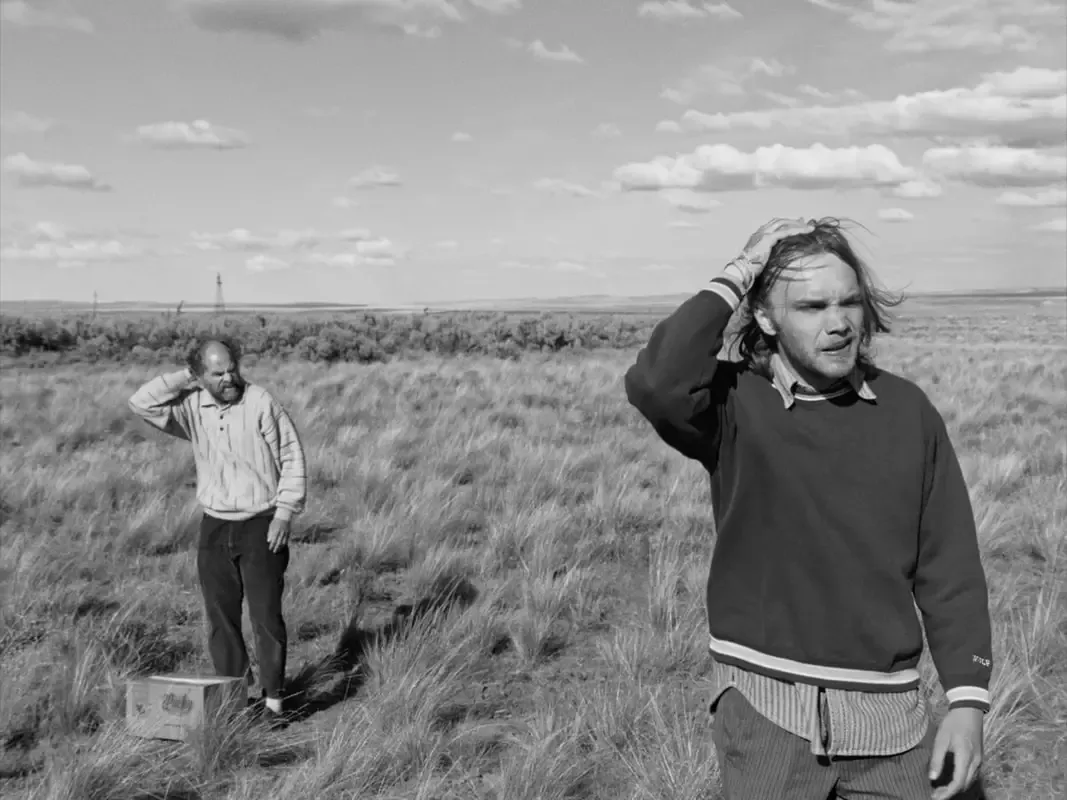
Slamdance Film Review: A Perfect Day for Caribou
Slamdance
A Perfect Day For Caribou
Director: Jeff Rutherford
Whether it’s biological traits from our parents, the habits of those we grew up with or a cosmic coincidence that puts us on the same path as our ancestors, we are the product of people who come before us. This can get especially difficult to reconcile with when you want nothing to do with that someone. In his film A Perfect Day For Caribou, writer/director Jeff Rutherford explores that reconciliation by focusing on the two people least likely to successfully do so: an estranged father and son.
The father, Herman (Jeb Berrier), is going to commit suicide. His girlfriend has kicked him out, he’s got nowhere to go and nothing to his name but an old truck and all of the belongings he could fit in its bed. He’s in the process of leaving his note—a tape recording of personal anecdotes so that his son can learn something about him—when he receives a call from that same son, Nate (Charlie Plummer). “Are you busy today?,” Nate asks.
The two men (as well as Nate’s 7-year-old son Ralph, played by Oellis Levine) meet in a cemetery in the middle of nowhere. It’s here that cinematographer Alfonso Herrera Salcedo’s gorgeous work kicks into high gear for the first time, making use of the film’s black and white tones to accentuate the landscape’s natural contrast. Setting the father-son duo’s conversation in the middle of nowhere was an intentional visual decision by Rutherford from the beginning. As he would point out in the Q&A following the film’s world premiere at Slamdance, he felt depriving the audience of color would highlight the clash between the setting’s Douglas fir trees and dried grass.
He was right to trust that feeling, as Herrera Salcedo turns the colorless landscape into something special. Everything in the cemetery is set against a seemingly endless expanse, which makes it all the more surprising when, after Ralph disappears, Herman and Nate’s search for the boy takes them into that expansive wilderness of both Oregon and their shared natures. Herman and Nate hop over the cemetery’s fences and run off toward the distant horizon and into the unknown. Rutherford mirrors the pair’s dive into the uncharted territory of their relationship—a stilted and uneven attempt at connection—with a literal journey into the unknown.
The script examines male relationships without actually examining them. Herman and Nate spend most of the movie talking about nothing while simultaneously telling each other everything about themselves. This is done in a very honest writing style, true to the inarticulate conversations men tend to have with one another when unequipped to express their feelings, whether by their fathers or the wider world itself.
The men’s conversation gradually reveals their similarities. They smoke in the same way and sometimes in unison, they have the same medicine for their collective heart condition and they both tend to make their romantic partners (Nate’s wife Sandy and Nate’s mom, respectively) miserable. Both Nate and Herman complain about their lovers’ antics, exposing how complicatedly pathetic these men are. The point of the film is their shared traits, their shared path.
These similarities would have been better off left for us to pick up on than to be foreshadowed by Herman’s opening notes into the tape recorder and the film’s title itself. In his initial monologue/suicide note, Herman mentions the migration path of caribou—caribou know where to go and what to do because it’s in their nature. The film circles over this a handful of times, in the ways I mentioned above, but also in the ease with which they follow Ralph’s path and—spoiler—find him in the end.
It isn’t just shared patterns that the men can’t seem to shake—it’s their old habits, as well. In the end, right as Nate finds and embraces Ralph, he turns to find that Herman has abandoned him again, just like he did when Nate was a kid. When Nate and Ralph finally make it back to the cemetery, where Herman’s abandoned belongings are waiting, Nate sits in his dad’s chair and waits for him to come back, just like he did when he was a kid.
One of my favorite films of all time is Jim Jarmusch’s Mystery Train. Without going too in depth, the film manages to encapsulate the feeling of walking through an unfamiliar city on a hot, summer night. It’s not the funniest or most beautiful film, but it entrances me every time and to this day I still can’t place how it accomplishes this, except maybe by the magic of cinema. I got a similar feeling while watching A Perfect Day For Caribou. Rutherford’s feature debut is a fun watch not in that it’s overtly funny or beautiful, but in that it transports you to the Oregonian wild, where two flawed men try very hard to say something meaningful while not meaning to do so whatsoever. I was happy to hear that feeling of similarity wasn’t an accident when, in the Q&A, Rutherford listed Jarmusch as an influence on this film.
The film has a natural, conversational sense of humor to it; an uneven rhythm which reflects the strain the two leads are feeling. At times, this impacted the pacing of the film, but I never felt it suffered much. In fact, this odd sense of rhythm was intentionally achieved by Rutherford by directing his lead actors to “only say the next line when you want to.”
While the title makes A Perfect Day For Caribou’s metaphor a little obvious, following Herman and Nate along the path of their shared blood and flawed traits is a quiet fascination to behold. With its intentionally uneven rhythm and inarticulate, conversational style, A Perfect Day For Caribou makes for a nice little slice of slow and unsteady monochrome. –Max Bennion